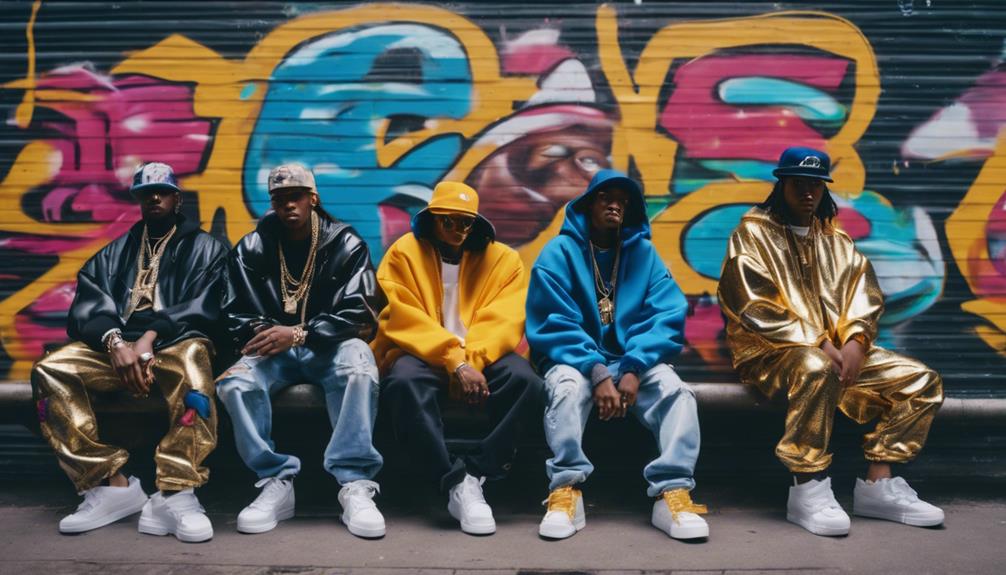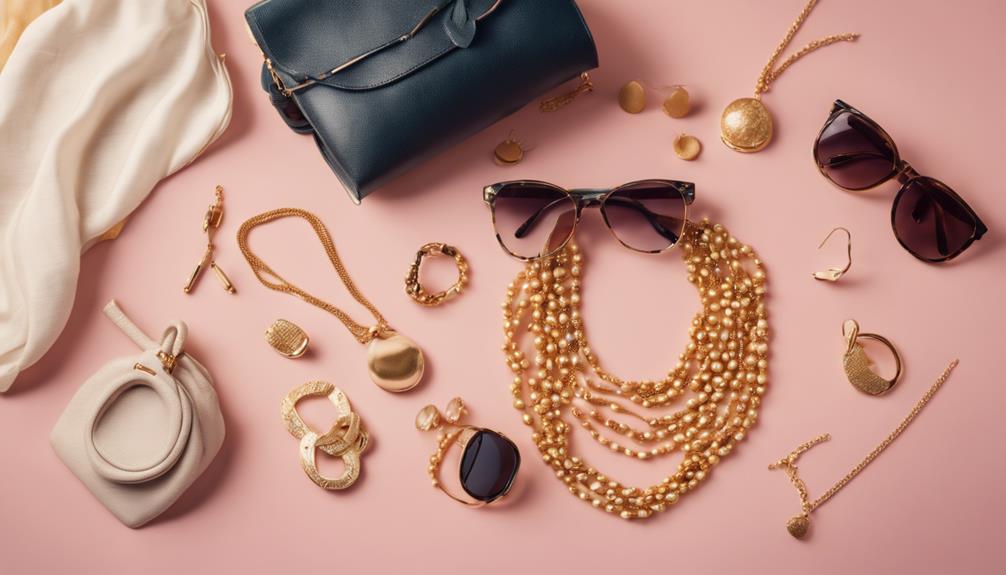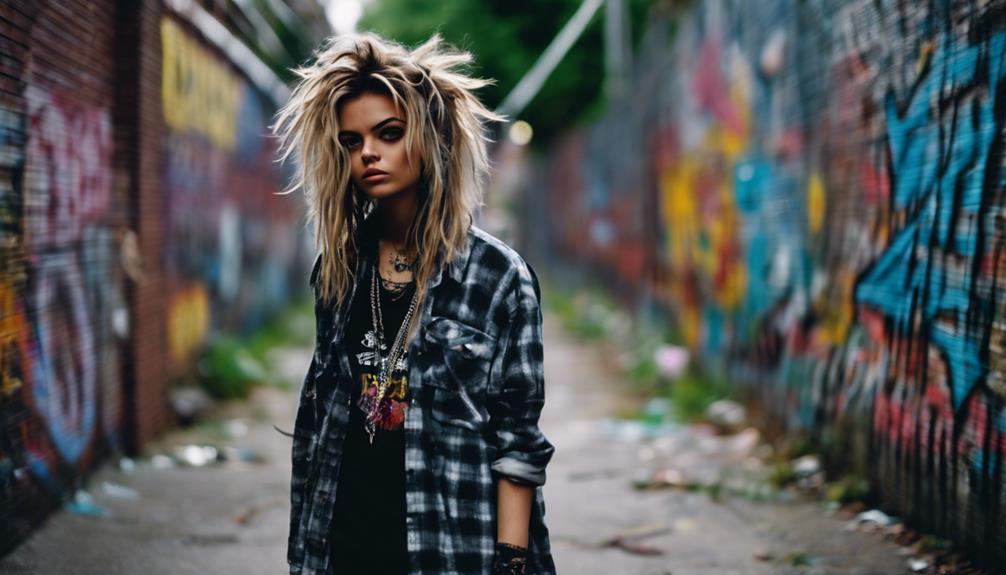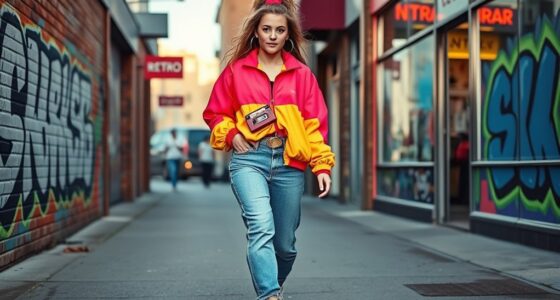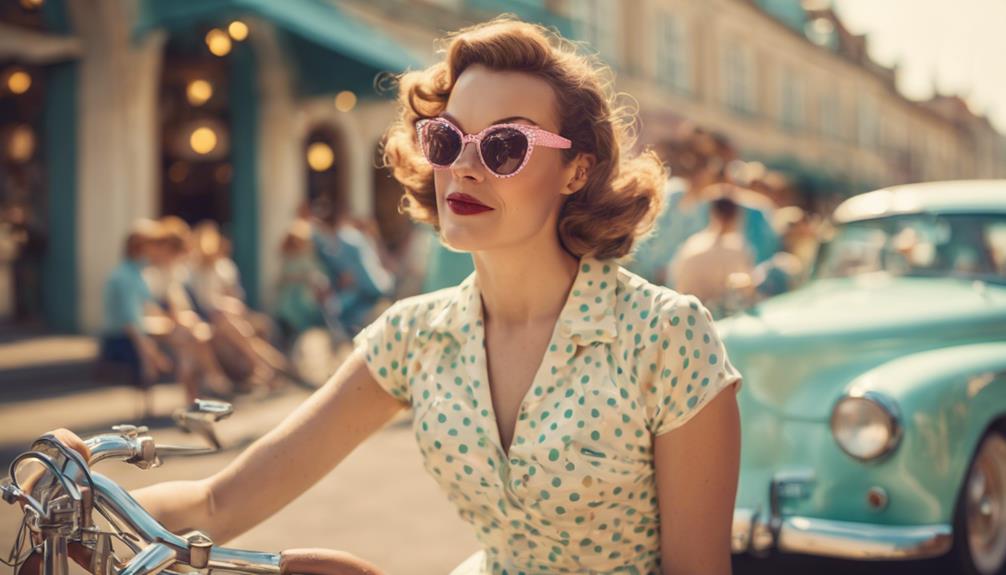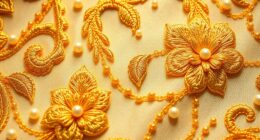Hip-hop fashion, which originated from the Bronx in the late 1970s, showcases styles that embody street culture and individual expression. Key elements such as oversized graphic tees, baggy jeans, and iconic gold chains are prominent, representing cultural pride. Artists like Run-DMC and LL Cool J popularized sportswear, bridging the gap between hip-hop and athletic fashion. Today, modern interpretations breathe new life into these timeless styles through innovative collaborations and sustainable practices. To capture the essence of that iconic era, explore styling tips and shopping guides that pay homage to the spirit. There is a wealth of information to discover about this influential trend!
Key Takeaways
- Hip-hop fashion originated in the 1970s Bronx, blending African American, Latino, and Caribbean influences to create a unique streetwear identity.
- Iconic items include oversized graphic tees, bomber jackets, tracksuits, and sneakers, which symbolize self-expression and community identity.
- The 1980s saw mainstream visibility with artists like Run-DMC popularizing sportswear brands, establishing a strong link between hip-hop and athletic fashion.
- Gold chains and vibrant primary colors became defining characteristics, reflecting wealth, status, and the bold visual impact of the era.
Origin and historical background of the fashion trend/style
Hip-hop fashion sprang from the vibrant street culture of the Bronx in the 1970s, where it transformed everyday aesthetics into a canvas for self-expression.
You'll notice how graffiti art and the urban environment shaped these styles, making them an essential part of hip-hop identity.
This unique blend of culture and creativity laid the foundation for what we now recognize as streetwear.
Transformation of Streetwear Aesthetics
Emerging from the vibrant streets of the Bronx in the 1970s, hip-hop fashion reflected the rich tapestry of urban culture and the distinctive identities of African American, Latino, and Caribbean communities.
As you explore this evolution, you'll notice how early hip-hop fashion showcased key elements like bomber jackets, tracksuits, and oversized sneakers. These styles served not just as clothing, but as symbols of identity and self-expression.
The 1980s marked a turning point, with artists like Run-DMC and LL Cool J bringing streetwear aesthetics to the mainstream. They broke fashion norms by embracing sportswear brands like Adidas and Puma, establishing a strong link between hip-hop culture and athletic fashion.
Bold colors and oversized clothing became staples, turning heads on and off the stage.
Graffiti Art and Street Culture
Graffiti art exploded onto the scene in the 1970s, becoming a powerful form of self-expression that captured the essence of urban street culture and the struggles of marginalized communities. Originating in the Bronx, NYC, it used vibrant colors and bold designs to convey messages that resonated with the youth.
This visual art form directly influenced hip hop fashion, leading to the rise of urban streetwear characterized by custom airbrushed t-shirts and unique styles. Artists like Keith Haring and Jean-Michel Basquiat played pivotal roles in bringing graffiti aesthetics to mainstream culture, merging street art with high art.
Their work highlighted social commentary, echoing themes found in hip hop music and reinforcing the bond between visual art and lyrical narratives. As graffiti gained traction within hip hop culture, it opened doors for collaborations between street artists and fashion designers.
You'd find pieces featuring graffiti-inspired prints becoming staples in urban fashion collections, showcasing the synergy between street culture and hip hop fashion. By embracing these elements, you connect with a rich history that celebrates creativity and resilience in the face of adversity.
Key Characteristics
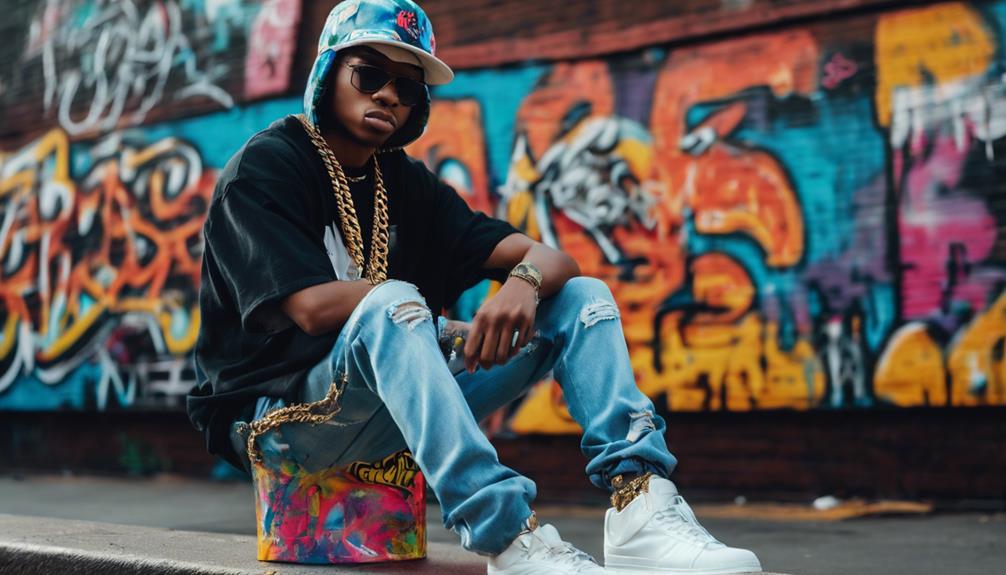
When you think of hip hop fashion, bold graphic prints and vibrant primary colors immediately come to mind.
You'll notice that gold chains and iconic sneakers also play a vital role in defining this style.
Together, these key characteristics create a unique and powerful expression of culture and individuality.
Bold Graphic Prints
Bold graphic prints in hip-hop fashion serve as powerful tools for self-expression, showcasing vibrant colors and intricate designs that reflect personal and political messages. These prints emerged prominently during the 1980s and 1990s, capturing the essence of urban cultural narratives. You'll often find oversized graphic tees as staples in hip-hop wardrobes, combining comfort with a bold visual impact that speaks volumes.
Many artists, including iconic groups like Run-DMC and Salt-N-Pepa, embraced these styles, making them synonymous with hip-hop culture. The designs frequently incorporate symbols and motifs that resonate with African American culture and civil rights themes, reinforcing a strong connection to social awareness. This rich heritage of bold graphic prints isn't just a fashion statement; it's a canvas for artists to communicate their stories and struggles.
Today, contemporary streetwear continues to revisit and reinterpret these iconic styles, ensuring that the spirit of self-expression remains vibrant and relevant. By wearing these graphic prints, you're not only making a fashion choice but also participating in a powerful dialogue that honors the roots of hip-hop and its ongoing evolution.
Vibrant Primary Color Palettes
Vibrant primary color palettes are a defining feature of hip-hop fashion, reflecting the genre's energy and individuality while enhancing the visual impact of oversized graphic tees, tracksuits, and accessories. These bold colors, primarily red, blue, and yellow, serve as a canvas for self-expression, allowing you to communicate empowerment and cultural pride through your wardrobe choices.
Designers like Dapper Dan played a significant role in popularizing these vibrant styles, blending luxury with streetwear aesthetics. Brands such as Cross Colours and FUBU embraced these bright hues, emphasizing themes of identity and community. The colors you wear can tell a story, making statements about your roots and beliefs.
Music videos from iconic artists like Aaliyah and Salt-N-Pepa showcased these vibrant primary color palettes, solidifying their association with hip-hop culture. These visuals not only influenced mainstream fashion trends but also highlighted the socio-political climate of the time, where colors became symbols of resistance and pride.
Wearing vibrant colors connects you to a legacy of artistic expression, allowing you to celebrate your identity while making a bold fashion statement.
Gold Chains and Sneakers
Gold chains and sneakers are essential elements of hip-hop fashion, symbolizing wealth, status, and cultural identity. Since the 1980s and 1990s, oversized gold chains, like chunky rope styles and large medallions, have been worn by artists to flaunt their success. These eye-catching accessories not only reflect personal achievements but also serve as a connection to hip-hop's roots.
Sneakers play a vital role in this fashion narrative, particularly brands like Adidas, Nike, and Puma. The Adidas Superstar, made famous by Run-DMC, became an icon, highlighting the collaboration that revolutionized the bond between music and fashion. This partnership marked the first major endorsement deal between a music group and a sportswear brand, setting the stage for future collaborations.
In the 1990s, Timberland boots emerged as a staple in hip-hop culture, initially designed for construction but adopted by artists like Jay-Z and Biggie for their gritty urban aesthetic. Sneakers have also evolved into canvases for artistic expression, with custom designs and limited editions like Kanye West's Air Yeezy line, further cementing their cultural significance in hip-hop fashion.
Modern Interpretation
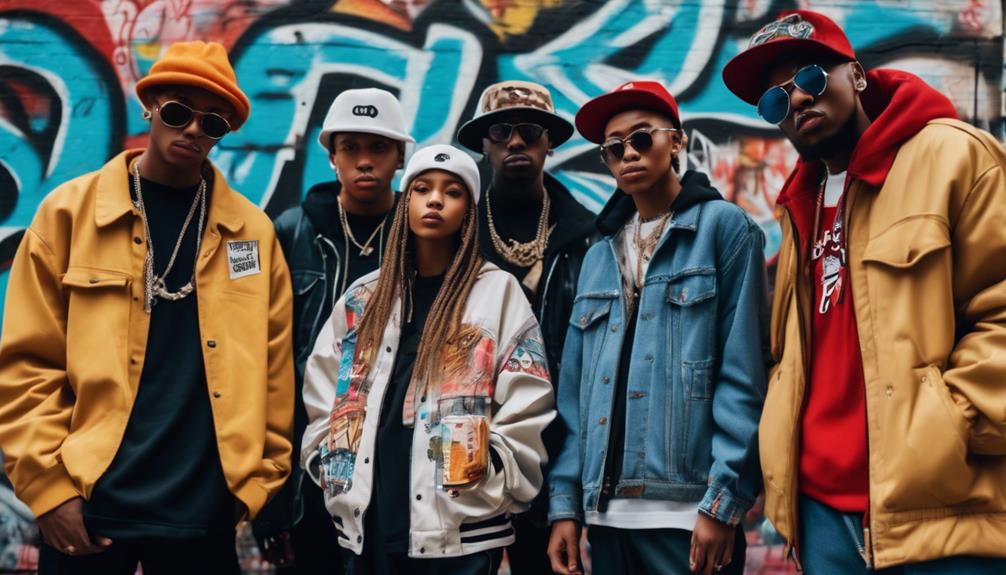
Modern hip hop fashion merges past and present through innovative collaborations with designers and brands like Nike.
You'll notice how fashion icons from the golden era influence today's streetwear, making classic styles feel fresh and relevant.
This blend of nostalgia and contemporary flair keeps the spirit of hip hop alive in your wardrobe.
Streetwear Collaborations With Designers
In recent years, streetwear collaborations with high-end designers have transformed hip-hop fashion, bridging the gap between urban style and luxury. You've likely seen how Kanye West's partnership with Adidas for the Yeezy line redefined sneaker culture, merging innovative design with street credibility. This successful collaboration didn't just sell out; it set new standards in high fashion.
Brands like Off-White, founded by Virgil Abloh, have taken this fusion further. Their limited-edition releases create buzz across both hip-hop and fashion communities, proving that streetwear can hold its own in luxury fashion.
Cardi B's collaboration with Reebok also highlights this trend, as her line promotes body positivity and self-expression, showing how hip-hop artists are reshaping mainstream fashion narratives.
Additionally, Travis Scott's unique sneaker designs with Nike, including the Air Force 1 and Dunk Low, illustrate how these collaborations not only sell quickly but also redefine sneaker culture by integrating hip-hop aesthetics.
As you watch major fashion weeks, you'll notice hip-hop artists walking the runway, a clear sign of the growing acceptance and influence of urban styles in the luxury fashion sphere.
Streetwear Collaborations With Nike
Nike's collaborations with hip-hop artists have redefined sneaker culture, blending innovative designs with personal styles that resonate deeply in both urban and luxury fashion.
You see this evolution through partnerships with artists like Travis Scott, whose Air Force 1 and Air Jordan 1 sneakers showcase unique materials and colorways that reflect his aesthetic. These designs have become highly sought-after items in streetwear.
Kanye West's Yeezy line revolutionized sneaker culture when the Air Yeezy 1 dropped in 2009, setting the standard for celebrity collaborations. Meanwhile, Virgil Abloh's ‘The Ten' collection merges high fashion with streetwear, illustrating hip-hop's significant influence on contemporary design.
Moreover, the Air Max 1 '97 x Skepta taps into the UK grime scene, showcasing how global hip-hop artists shape sneaker trends.
Nike remains committed to engaging with hip-hop culture, continually releasing limited-edition sneakers in collaboration with stars like Cardi B and Pharrell. This ongoing partnership highlights the seamless blend of streetwear and high fashion, emphasizing the vital role hip-hop artists play in defining today's sneaker culture.
Fashion Icons of the Era
Hip-hop fashion continues to evolve, with current icons redefining style and pushing boundaries just as pioneers like Run-DMC and Dapper Dan did in their eras. Today, artists like Missy Elliott carry the torch, bringing bold colors and futuristic shapes to the forefront. Her experimental looks not only challenge traditional fashion norms but also inspire a new generation of female representation in Hip Hop.
Oversized clothing remains a staple, echoing trends set by The Diplomats, particularly Cam'ron, whose pink mink coat became a symbol of luxury and audacity. This embrace of extravagant styles showcases the intersection of fashion and self-expression in the culture. Gold jewelry, with its roots in hip-hop's history, continues to signify status and success, worn by rising stars and seasoned veterans alike.
Dapper Dan's legacy lives on as contemporary designers blend high fashion with urban styles, making luxury accessible to all. The adaptability of these iconic styles proves that hip-hop fashion isn't just a fleeting trend; it's a powerful statement of identity and cultural pride that continues to influence the broader fashion landscape.
Styling Tips
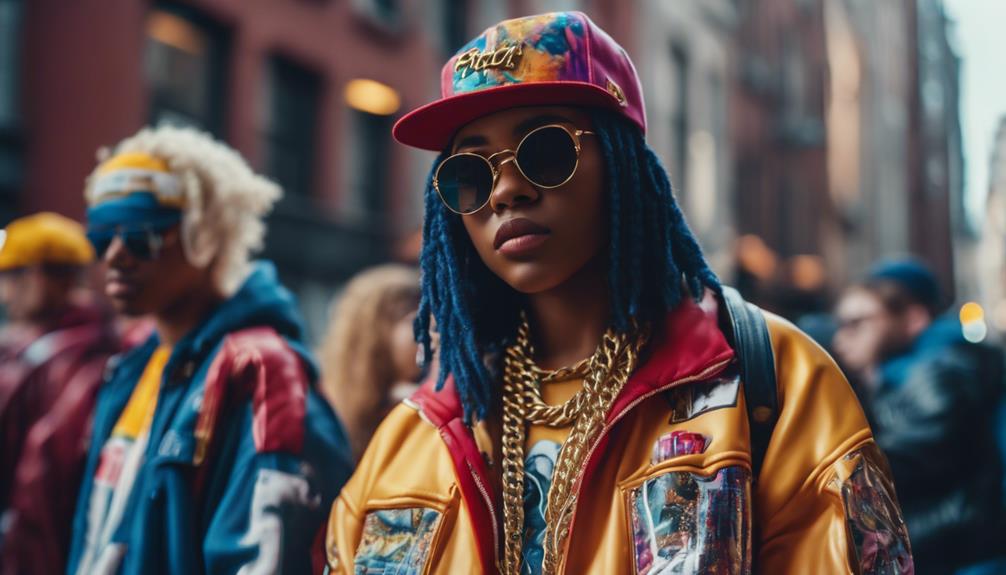
When it comes to hip hop fashion, styling tips can elevate your look effortlessly.
Think graphic tees paired with baggy jeans or cargo pants for a laid-back vibe that captures the essence of the culture.
Layering with oversized pieces adds depth and keeps your outfit fresh and bold.
Graphic Tees and Baggy Jeans
For a laid-back yet stylish look, you can't go wrong with pairing a bold graphic tee and baggy jeans, creating a perfect blend of comfort and self-expression. This iconic style, rooted in the golden era of the hip hop scene, not only reflects your personality but also pays homage to the cultural movements of the '90s. Choose graphic tees that feature vibrant colors or meaningful messages, showcasing your personal expression.
When it comes to baggy jeans, opt for a fit that allows freedom of movement while maintaining that relaxed style. Brands like FUBU and Cross Colours are great inspirations if you want an authentic feel.
To elevate your outfit, accessorize with oversized gold chains, which add that classic hip hop flair. Footwear plays a vital role too; consider rocking sneakers like Adidas Superstars or Timberlands to complete your look.
Graphic Tees With Cargo Pants
Pairing graphic tees with cargo pants creates a relaxed yet edgy style that embodies the spirit of 90s hip-hop fashion.
To nail this look, choose graphic tees that feature bold colors and striking designs, showcasing your personality. Opt for cargo pants with a loose fit, as they not only provide comfort but also align perfectly with the oversized aesthetic of that era.
When it comes to footwear, oversized sneakers like Nike Air Force 1s or Timberlands are ideal. They enhance the hip-hop vibe while ensuring practicality for everyday wear.
To elevate your ensemble, don't shy away from accessories. Chunky gold chains or bucket hats can add that extra flair, transforming your outfit into a statement-making masterpiece.
Layering With Oversized Pieces
Layering oversized pieces can transform your hip-hop look into a bold statement that embraces comfort and style. Start with a baggy t-shirt over a long-sleeve shirt or hoodie for that classic 90s vibe. This not only adds dimension but also maintains that signature relaxed aesthetic.
To elevate your hip-hop outfits, consider incorporating oversized jackets—denim or bomber styles work great—providing a striking statement while staying rooted in streetwear.
Pair your oversized pants or joggers with a fitted top to create a balanced silhouette, ensuring you can move freely while rocking the iconic comfort-over-formality norm.
Accessories play a crucial role too; think chunky gold chains or oversized sunglasses to enhance your layered look and emphasize hip-hop's flashy, expressive nature.
Don't shy away from vibrant colors and patterns either; these elements reflect the artistic graffiti culture of the 90s and can help you channel that era's cultural significance.
Shopping Guide
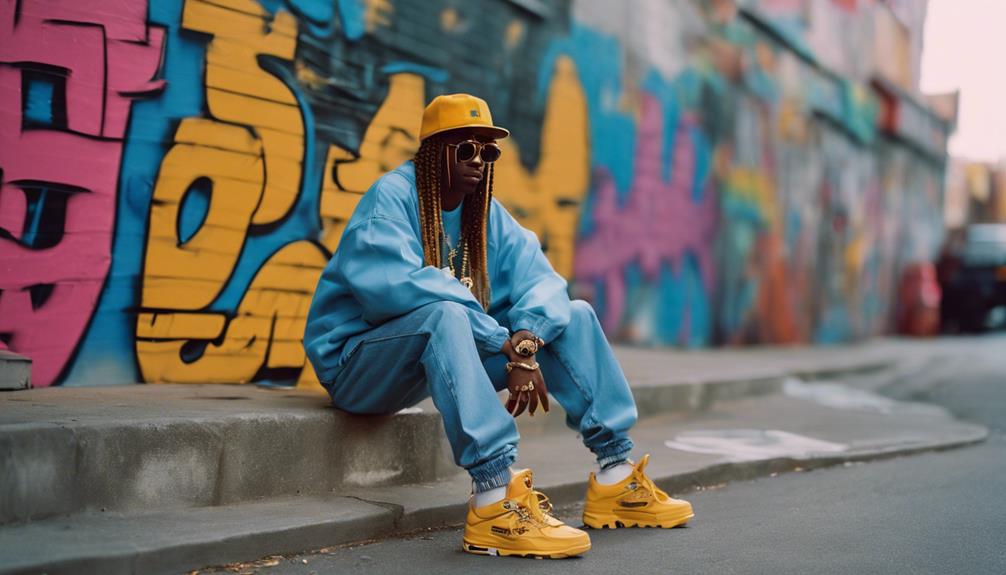
If you're looking to embrace 90s hip hop fashion, exploring vintage clothing stores and online marketplaces is a great way to find authentic pieces that reflect the era's iconic style.
Start your search at thrift stores, where you can discover hidden gems like oversized t-shirts, dungarees, and even Timberland boots—all at budget-friendly prices.
Online platforms like Depop and eBay also feature a wide array of retro hip hop apparel, allowing you to shop for unique finds that encapsulate that nostalgic vibe.
Don't overlook retailers like Urban Outfitters, where modern interpretations of classic hip hop styles keep items like snapbacks and graphic tees accessible for today's fashion enthusiasts.
For those who want a curated experience, consider subscription services that offer tailored curated streetwear styles inspired by 90s aesthetics. These subscriptions can introduce you to pieces you mightn't have found otherwise.
Upcycled Vintage Clothing Techniques
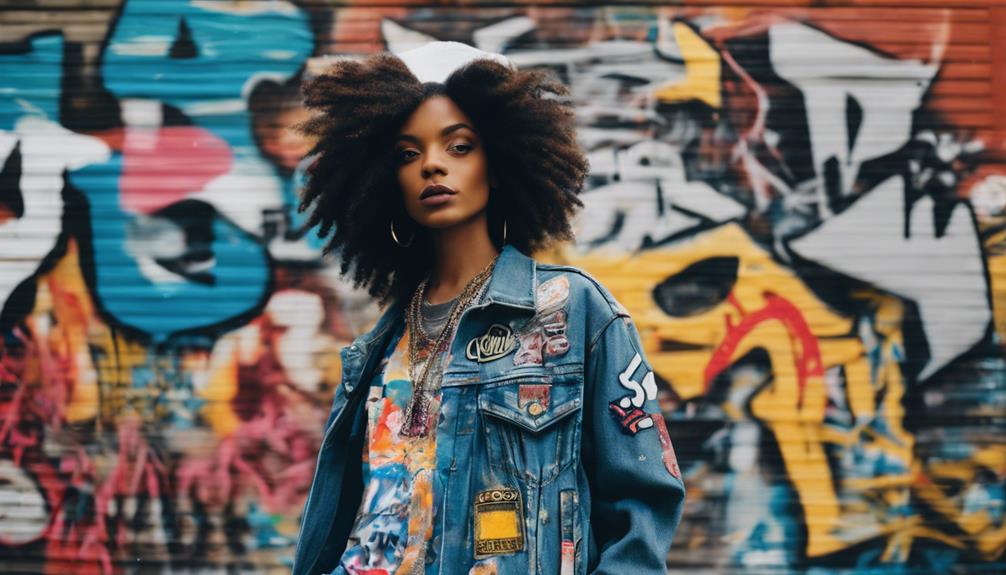
When it comes to upcycled vintage clothing, you can transform old pieces into fresh styles using restoration techniques that breathe new life into your wardrobe.
DIY patchwork is just one way to showcase your creativity while embracing the vibrant spirit of hip-hop fashion.
Let's explore how these methods can help you create unique looks that reflect your personal style.
Vintage Clothing Restoration Techniques
Upcycling vintage clothing breathes new life into worn pieces, allowing you to creatively blend techniques like patchwork, visible mending, and dyeing for a unique and sustainable wardrobe.
By sewing remnants of fabric together, you can craft unique designs that keep the original garment's character while enhancing its appeal.
Repairing worn-out areas with visible mending, using contrasting thread, not only beautifies the piece but also promotes sustainability by extending its lifespan.
You can also utilize dyeing techniques, like tie-dye or natural dyeing, to revitalize faded vintage items with fresh colors and patterns that resonate with today's trends.
Don't forget about embellishments! Adding beads, sequins, or fabric paint can transform basic vintage clothing into statement pieces that reflect your personal style while preserving their retro charm.
Additionally, using fabric from other vintage garments for alterations lets you engage in creative reinterpretation, whether that means crafting new collars or sleeves.
Embracing these restoration techniques not only honors the history of the pieces but also allows you to curate a wardrobe that's both stylish and sustainable.
DIY Patchwork Techniques
As you explore DIY patchwork techniques, you'll discover how to transform fabric scraps into one-of-a-kind garments that celebrate both sustainability and individual style. By upcycling vintage clothing, you not only reduce waste but also breathe new life into pieces with historical significance in hip hop culture. This method allows you to incorporate iconic elements from the 90s hip-hop era, such as colorful patterns and denim, reminiscent of artists like TLC and The Diplomats.
To get started, gather your tools—a sewing machine, fabric scissors, and colorful thread are essential for enhancing your creations. As you stitch together different fabrics, you release your creative expression, crafting unique items that reflect your personal flair. This resurgence of DIY fashion has gained momentum, with social media platforms buzzing with tutorials that connect a new generation to hip hop's rich fashion legacy.
Embracing these DIY patchwork techniques not only showcases your individuality but also aligns with today's focus on sustainability. So immerse yourself in your fabric stash and start crafting garments that tell your story while honoring the vibrant history of hip hop fashion!
Cultural Impact
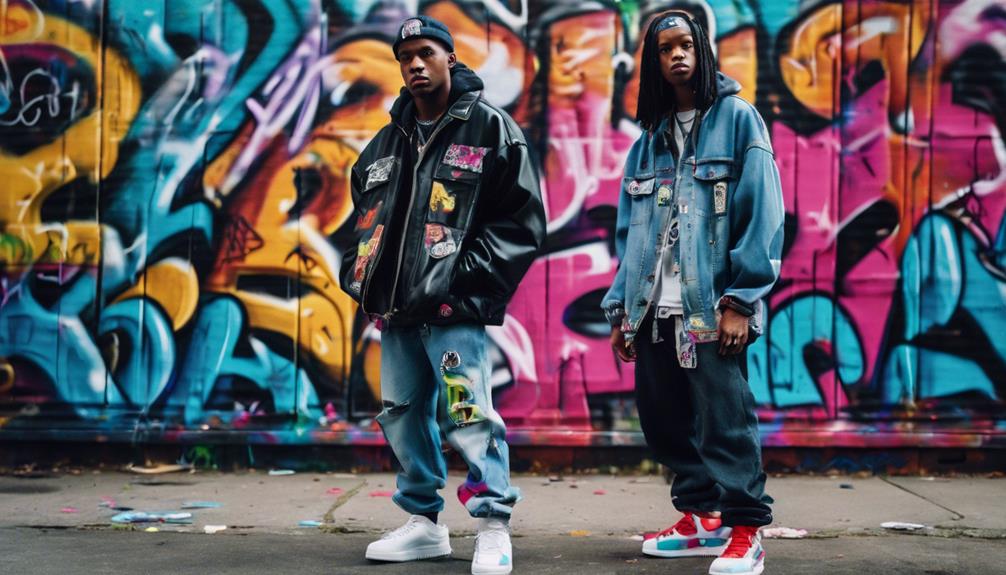
When you think about hip hop fashion, it's hard not to recall those iconic music video moments that defined styles and set trends.
These visuals not only showcase bold fashion choices but also weave in themes of civil rights and self-expression, highlighting the genre's deep cultural roots.
As you explore these connections, you'll see how hip hop fashion has shaped and been shaped by societal movements over the decades.
Music Video Fashion Moments
Music videos have become powerful showcases for hip-hop fashion, with artists like Missy Elliott and Aaliyah redefining style and influencing fans worldwide. These visual platforms highlight iconic outfits that set new standards in hip-hop fashion, making bold statements about individuality and cultural identity.
For instance, who could forget Cam'ron's pink mink coat in 'Wet Wipes'? It symbolizes not just a fashion choice but a lifestyle embraced by many.
The storytelling through fashion in music videos often blends streetwear with high fashion, reflecting the unique identities of the artists. Rappers like Snoop Dogg popularized casual styles, including plaid shirts and oversized pants, which considerably influenced mainstream fashion trends. As you watch these artists, you can't help but notice how their styles resonate with youth culture, prompting fans to adopt similar looks.
The impact on consumer behavior is undeniable. Fans want to emulate their favorite artists, leading to rapid trend adoption and the rise of specific brands linked to hip-hop culture.
Ultimately, music videos have played a vital role in shaping both hip-hop fashion and the broader fashion landscape, making them essential viewing for style enthusiasts.
Civil Rights and Hip-Hop Fashion
Hip-hop fashion has long served as a powerful medium for expressing social consciousness and cultural identity, deeply rooted in the struggles for civil rights. During the 90s, it emerged as a vibrant reflection of social awareness and Black identity within urban culture.
Artists like Tupac and Public Enemy used their clothing choices—think military gear and bold accessories—to challenge societal norms and highlight issues of inequality and injustice.
Graffiti clothing and custom designs became artistic expressions that showcased the resilience of marginalized communities. This fashion wasn't just about looks; it was a statement of pride and resistance against oppression.
Sports jerseys bridged the gap between music and sports, symbolizing support for Black athletes and celebrating their contributions within the civil rights context.
Iconic accessories like Kangol caps and oversized gold jewelry represented more than status; they reinforced a collective cultural identity, connecting hip-hop to the ongoing fight for racial equality.
Through these styles, hip-hop fashion transformed into a canvas for social critique, reflecting the struggles and aspirations of those advocating for justice and equality in society.
Frequently Asked Questions
What Was the Golden Era of Fashion?
The Golden Era of fashion refers to a transformative period in the late 20th century, where bold aesthetics, innovative styles, and cultural movements merged, shaping trends that still influence today's fashion landscape. You're witnessing its lasting impact.
What Is the Hip Hop Style of Fashion?
Hip hop style of fashion blends casual, oversized clothing with urban influences. You'll find baggy pants, tracksuits, and bold accessories like Kangol hats and chunky jewelry, all reflecting cultural identity and self-expression in vibrant ways.
What Is the Iconic Hip-Hop Look?
The iconic hip-hop look features oversized clothing, like baggy pants and puffy jackets, along with signature sneakers and bold accessories. You'll also find essential headwear that completes your stylish, comfortable, and expressive urban vibe.
What Was so Unique About the Golden Age of Hip Hop?
The Golden Age of Hip Hop was unique because you saw a blend of music, culture, and social issues. Artists expressed themselves through innovative sounds, powerful lyrics, and an evolving fashion that resonated deeply with audiences.
What Influence Did Hip Hop Fashion Have on Kpop Fashion?
Hip hop fashion has significantly influenced the trendsetting kpop fashion styles. The bold and streetwear-inspired looks from hip hop culture have made their way into Kpop fashion, with baggy pants, oversized tops, and unique accessories becoming popular among Kpop idols and fans alike.
What Are the Iconic Styles From the Golden Era of Hip Hop Fashion?
The iconic 90s hip hop fashion was characterized by oversized denim, bold tracksuits, and colorful windbreakers. Accessories like chunky gold jewelry, snapback caps, and Timberland boots were also essential to complete the look. This era also popularized baggy pants, graphic tees, and iconic sportswear brands like Adidas and Nike.
Conclusion
To sum up, hip hop fashion from the golden era continues to inspire and influence styles today.
By embracing its key characteristics and modern interpretations, you can make a bold statement while celebrating its rich history.
Remember to incorporate unique styling tips and explore upcycled vintage options for a fresh twist.
As you shop and experiment, you'll not only showcase your individuality but also honor the cultural impact that this iconic fashion trend has had on the world.
